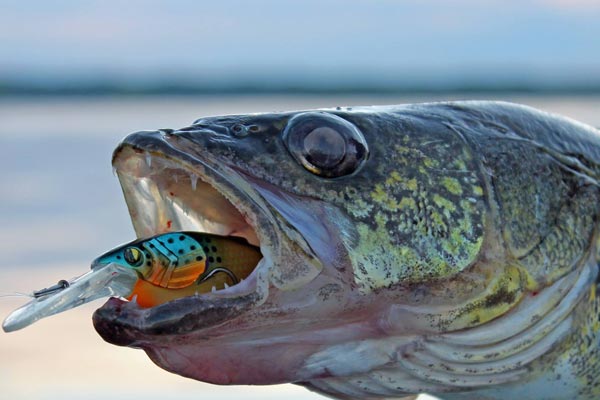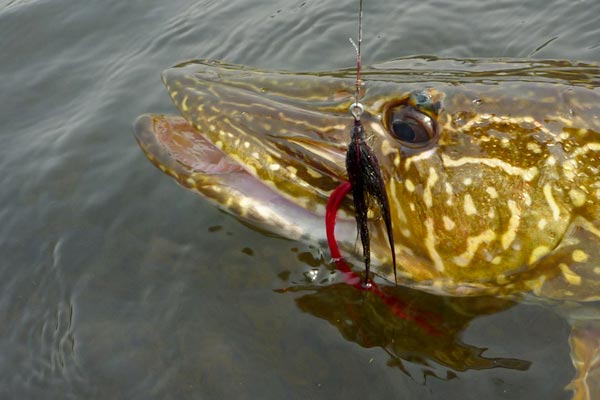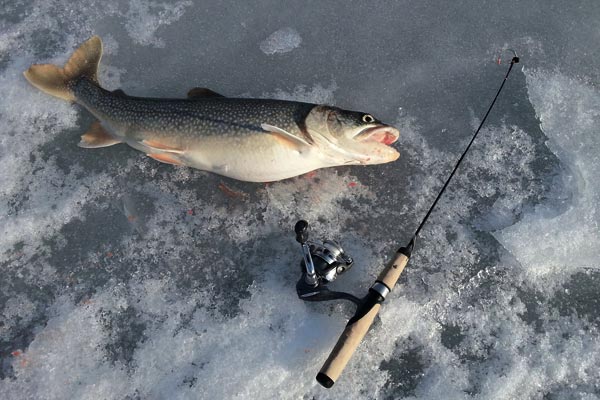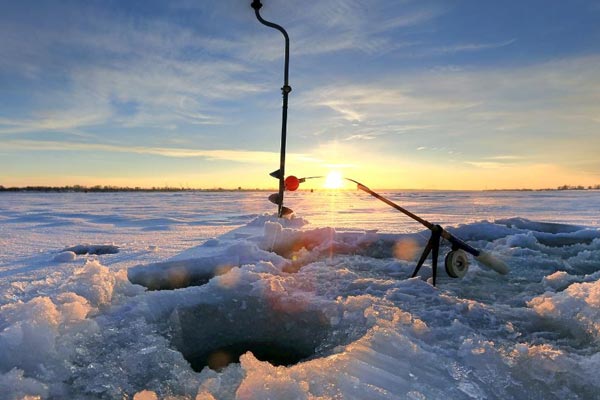Walleye is a type of fish belonging to the perch family that is found in the freshwater areas in North America and Canada.
‘Sander vitreus’ is walleye’s scientific name. There are two subspecies of walleye that is: yellow walleye and blue walleye.
The walleye gives eyeshine in darkness being a nocturnal animal due to a light-gathering layer on its eyes.
This enables easier visibility. Its name comes from its eyes which tend to face the walls externally.
What depth of water does walleye live?
According to World Fishing Network Walleye tend to populate deeper lake regions due to their excellent vision.
Their eyes also enable them to see in breaking waters. They also feed on their prey at night in deep waters.
How do walleyes reproduce?
During late winter periods or early spring, female walleyes move to lay eggs in stream tributaries.
Some of them put on sand or vegetation. 6°-10° Celsius that is 43°-50° F is the best temperature for spawning.
Male walleyes mature sexually between 3 to 4 years whereas females mature a year later.
Females lay up to 500,000 eggs according to Ohio Sea Grant. Within a month, the embryos hatch and spend a full week on yolk absorption.
After that, they feed on invertebrates. After a duration of 40 to 60 days, they begin to feed on fish like minnows and crayfish.
How long does it take for walleye to grow?
Male walleyes mature at three years and grow to about 20 inches long with a life expectancy of 15 to 20 years.
According to World Fishing Network, female walleyes take a more extended period that is five years and also tend to live longer than males.
Difference between a male and a female walleye
Female walleyes are plump, and rounder whereas men are slimmer and lighter. Male walleyes discharge a white fluid for egg fertilization and therefore monitoring their behavior can help to know the gender.
The posterior can also be used in that the male anus is circular whereas a female anus looks like a keyhole and it is larger during egg laying period.
Walleye’s length, weight, and structure
Walleyes can weigh up to 9 kilograms and 180 centimeters long. Their mouths have large, sharp teeth with spinous anal and dorsal fins.
They are mainly gold in color or olive and possess five darker saddles which extend to their upper side whereas the belly shades to white.
Distinguishing a walleye from a sauger
Walleyes and saugers being close relatives can bring about confusion. The sauger lacks a white color on the caudal fin’s lower lobe.
Instead, it possesses black spots on its caudal fin which are absent on the walleye’s caudal fin.
Can walleye see red?
Walleyes possess a color vision and thereby tend to see color orange best in clear waters. However, In darker conditions, they know the color red or yellow.
They have reduced the visibility of the colors violet and blue, and at times, they may appear as black to them.
World’s largest walleye
The world’s largest walleye ever recorded was in 1960. The walleye weighed 25 pounds and measured 41 inches long. Mabry Harper caught the walleye in Tennessee state at Old Hickory Lake.
The best temperature for walleye fishing
Warm conditions tend to concentrate walleyes onto the ice. The optimum temperature for fishing walleye is in the lower range of 70° F. Walleye spawning grounds are also great to catch walleye.
Best color jig for walleye
Orange, green and red are ideal jigs for walleyes. As walleyes love breaking waters, the most visible colors are these.
They appear brightest to them thereby attracting them. A fluorescent orange color jig will be an ideal option for walleye fishing.
Walleye fishing at night
The night can be useful for walleye fishing but can also be quite risky due to the darkness according to Ontario Walleyes.
This requires effective planning and preparation as an angler. Places like gravel beds, weeds and sandbars are an excellent location for walleyes.
As an angler, taking a headlamp with you is a good idea. However, be cautious since the light intensity can disrupt walleye feeding. This can cause movements into darker places thus missing your catch.
Avoid thick vegetation because it’s hard to see prey for walleyes. In shallow waters, shallow minnow baits are used while in areas around the shore, and floating minnow baits are used.
Also, spinning wheels are better off than bait cast reels as they prevent a possible backlash.
Ice jigging for walleye
Walleyes make minimal long-distance movement due to the low temperatures. However if at all, they make horizontal changes, they are slower than in summer.
This is an advantage to anglers as they set up the road structures to trap the walleye according to Walleye Movement Studies in Lake Erie.
Structures are set up by anglers at noon by hole drilling to cover walleye feeding spots. The holes vary in depth from shallow, mid-depth to deep.
The first expedition takes about 10 minutes, and anglers then move to shallow and mid-depth holes to jig walleye out.
Walleye ice fishing lures
While ice fishing needs tricks, it also requires proper equipment. The most commonly used are spoons, swimming lures, and jigs. With them, walleye ice fishing becomes more accessible for anglers.
Swimming lures
They work best in clear waters at dawn break and are designed to resemble bait fish. They attract movements that cause walleye bites if used in correct jigging.
They work well on weed beds and structures. (Rapala jigging rap is recommendable as the best seller by Amazon)
Spoons
They are of various weights, sizes, and shapes. They produce vibrations when placed in water. They tend to imitate dying, therefore, attracting walleyes and are best used in clear water. (South Bend Kastaway Trophy Spoon is recommendable as the best selling by Amazon)
Jigs
Anglers prefer jigs for walleye fishing. They are a good combination together with baits. They are placed into the water depth of the walleye and used either passively or actively. (Northland Whistler Jig is the best selling product recommendable by Amazon)
Other fishing lures for walleye
1.Crankbaits
Use of crankbaits for walleye fishing can be quite useful for an angler. However, some factors to consider before choosing a preferred one are color, action, depth, and size. This is to ensure the best catch of walleye as an angler.
a. Depth
Majority of the crankbaits provide optimum depth range. As an angler, you should consider how deep a crankbait runs as its essential. This will enable you to make a choice depending on the place of fishing intended.
b. Action
The broader a crankbait is, the higher the work it performs. The straighter a lip tends to be with the center, the more wobble produced to catch the fish. Settling for a wider crankbait will enable you as an angler to have a successful expedition.
Also, you can adjust it manually although this comes as experience due to continuous use over time.
c. Size
The ultimate crankbait size should be the best one for the base size you prefer: for white basses, smaller sized lured are used while larger lures are used for largemouth basses.
As you fish, if at all you feel the urge to use a more prominent bass, tie a more massive bass to determine the potential. For bigger walleyes, use bigger lures too.
d. Color
Shady colored crankbaits are preferable if the walleye are feeding on baitfish. In fishing, this is called, ‘matching the hatch.’
This enables successful fishing expeditions by anglers. (Killer Walleye is the best selling crankbait as recommended by Amazon)
2. Spinners
These spinners are cast, trolled or drifted onto the waters. Depending on the fish target by anglers, spinners range as from 10-15 pounds.
As an angler, it’s advisable to choose a hard surfaced one with the best abrasive resistance. (Berkley walleye Colorado 5 Fluorocarbon Flicker Rig is the best selling product by Amazon).
3. Soft plastics
They give a fish a natural feeling when it encounters it. This, in turn, provides an angler with time for setting up a hook to catch the walleye.
Soft plastics vary in types such as worms, grubs, bait fish, tubes, crawfish as well as leaches. (Wtrees is the best selling product in Amazon).
4. Fishing lines
They are a good option in that as an angler, and you feel vibration thus enabling you to know whether to clean off or either reel in. Superlines are the most commonly used fishing lines among others like fluorocarbons, nano braids, and mono.
Decide on which fishing line to use depending on your preference as an angler. (Spiderware braided stealth super line is the best selling product in Amazon)
Is it ok to eat walleye?
Yes, it’s okay to eat walleye. Walleye is one of the tastiest freshwater fish in the world. It’s mildly flavored and an excellent dish.
Any walleye between 14-20 inches is good for eating According to Walleye Message Central. It’s also advisable to eat younger walleye’s. Younger walleye fillets cook better and perfectly as compared to the large ones.
Big walleyes are not preferable in the fact that they may contain contaminants. They may also include high mercury levels which pose a threat to human life.
This is because they have lived longer in the ecosystem thus may have absorbed contaminants in the water too.
Eating walleye is quite healthy due to the nutritional value of the fish. Walleye are excellent sources of proteins: specifically Omega-3 fatty acids. Omega-3 fatty acids help in building the body parts such as the heart and the brain.
However, expectant mothers, as well as children under 15 years, should eat walleye which are below 20 inches. Other adults can eat walleye fish once or more times each week.
How to cook Walleye
There are various ways to cook walleye at home. Walleye can either be found frozen or fresh in markets.
Some of the conventional methods used in the preparation of walleye include pan frying and grilling, Oven roasting, poaching as well as steaming.
Fresh lemon juice, pepper, salt are used to give you a yummier taste of walleye.
1. Poaching
Place walleye pieces in a water pot below the boiling point for approximately 6 minutes. You can also cream sauce the fillets after cooking. Poaching can also be done in soup too.
For microwave poaching, In a sauce, oil, minced garlic and grated ginger, marinate walleye for 20 minutes. Cook it on high temperatures at approximately 3 minutes each side.
2. Steaming
According to J.D. Schuenemeyer, this is an excellent method where walleye cooks gently in liquids such as white wine in little amounts.
To do this, wrap walleye fillets in aluminum foil and steam them in 400° F oven and let them cook for about 10 minutes.
You can also add garlic, chopped basil, vegetables such as tomatoes so that they cook alongside it.
3. Oven roasting
Oven roasting works best i6 instances where your walleye fillets are at least an inch thick. To do this, spray oil over the fish or either coat the walleye with oil, herbs or breadcrumbs.
After the procedure, leave the walleye to cook in the oven at 475° F for a quarter an hour or a third, you can also wait till the fish fillets flake or your thermometer reads 140° F.
4. Grilling
According to Allrecipes, grilling gives walleye a crusty surface thereby differentiating it from the inner soft, flaky part of it.
If you are cooking your walleye directly on the grill, oil the cover and place the fish on top of the restaurant.
After heating up the grill, let your walleye cook for approximately 3 minutes on each side, you can use a fork to know whether it’s ready as it appears opaque when you spread it apart.
Walleyes are a beautiful part of mother nature and are also known as pickerels by some individuals.
Being predators, they help regulate aquatic ecosystem through balancing it. They also are diets to most Americans who like white meat.



